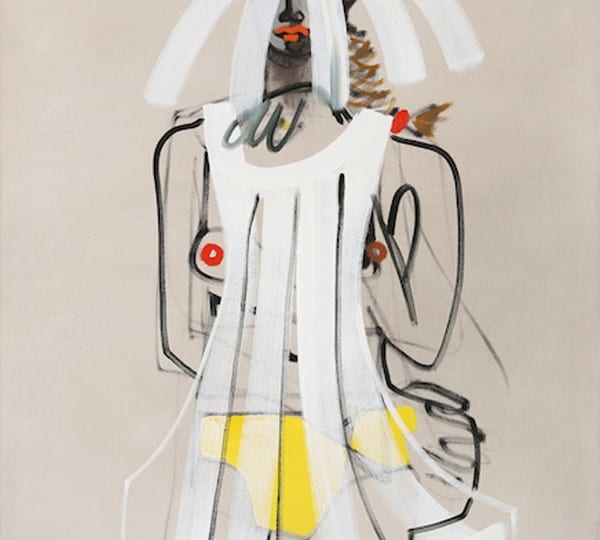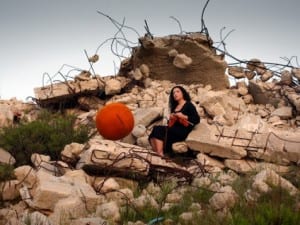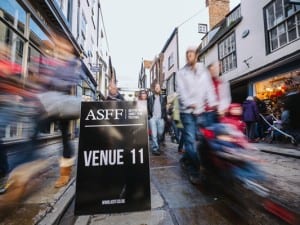Rough Deluxe: Sweet Candy and Wild Women is a new collection from painter Henrietta Dubrey and is currently on display at Edgar Modern, Bath. The exhibition features a stunning new body of work, encompassing both abstract and figurative works. Running until 11 April, the show highlights Dubrey’s reimagining of the classic female nude with bold colours that demand attention. We speak to Dubrey about her practice and the artists that have influenced her over the years.
A: What can audiences expect to see in this show?
HD: Audiences will see the dichotomy between my abstract genre and my figurative works. At the same time, because viewers are given the chance to see the works side by side in an exhibition space, they are able to read the similarities in the mark-making that make the paintings work together and cohere to make an overall picture of my current oeuvre. Rough Deluxe explores the themes of our over-materialistic society in the abstracts, which consist of brightly coloured saturated canvasses. Bold compositions cry out for attention, wanting to be seen as beautiful objects in their own right, The works contrast with everyday life and its internal and external influences, which seep into our subconscious.
A: Where do you find inspiration for the figures in your work?
HD: I have been drawing and painting figures for as long as I can remember. I rarely work from life. It is something I am considering doing again. Having spent three years at the Royal Academy Schools in London the importance of this study is deeply embedded in my psyche. The discipline taught at the RA was intense and fulfilling and something that I miss. I remember as a child I was rather obsessed by the naked figure and used to fill sketch books with rather elongated pencil studies of female nudes. Maybe it was a way of coming to terms with my own physical development, but it was also a way of fantasising about an adult world and the romantic view one often assumes will arrive with maturity. In reality the inspiration for my figures still comes mainly from my imagination and is strongly driven by the way it feels to embody a body, and the spirit of the mind. This is especially relevant to the paintings I consider to be autobiographical or self-portraits such as in Sense (2014). The more narrative iconic figures which may or may not be clothed, are most probably informed by my looking at paintings, painters, art history, magazines, photographs, films and “cultural” videos. I am also influenced by Keith Vaughans’s neo-Romantic male nudes that veer towards cubism, William Scott’s female nudes, Picasso’s figures that developed and changed so much over his lifetime, and De Kooning’s series on women.
A: In your writing about the exhibition you mention decadence and luxury, what is it that draws you to these things?
HD: I think that the location where I live and work is physically quite remote from the hustle and bustle of, say, London and the Continent. Although surrounded by beautifully rugged landscape, it was the mid-generation St Ives artists that drew me to relocate here originally. There is a certain “mainstream” culture that one can feel slightly starved of, removed from at times. Visits to London and favourite haunts such as Soho and the area surrounding the Royal Academy are a necessity for me, and I cherish these visits to use as inspiration back in the studio. While I am there I take photographs and collect catalogues, postcards and speciality goods. Bookshops and newsagents and the proliferation of magnificently produced magazines can bring elements of luxury and decadence straight to your home. The ideas, the glamour and the freedom to express are endlessly explored. These magazines surround me in the studio; I can dip in and in a moment be transported to another world, of an artist, a composer, a poet, writer, photographer or a fashion designer. Artists’ interviews fascinate me, their studios, working practices and homes and what they choose to collect and surround themselves with; it is all information I love to absorb. Information is so readily available now, one almost feels like a voyeur invading private spaces and being able to mentally travel wherever one pleases. Dreams can become a reality at the flick of a switch. You can metaphorically transport to the South of France, to New York, to the front row of the latest catwalk collection. In this respect I think that luxury and the need to dream can somehow seem closer than it might do in reality, and that in itself is a powerful resource. The elements of decadence in the work question whether we should seek the luxury that is portrayed, or whether advertising makes us greedy for newness just for its own sake. Some of what I am attracted to might be a bit risqué or controversial, yet I personally feel the need to look and be informed. In truth then, living in such a quiet spot, which enables me to be very undistracted if I want or need to be, there is always the temptation to head to the computer and relieve that solitude and flood the mind with new images.
A: Do you have any particular attitude towards the history of the representation of the female figure?
HD: The female figure has been represented in art in so many different forms, and it would be impossible to deny that influence on my own work. I once wrote an extended essay on the myth of the Mother Goddess and have always felt an affiliation with very early representations of woman, such as the Venus of Willendorf c.25000 BC. The powerfully depicted sexual attributes of this and other small sculptures emphasise their fertility and voluptuousness. Up until the Renaissance the female nude was relatively unimportant and the young male body was seen as the embodiment of the gods. From the Classical period the female nude has been ever more present from sleeping Venuses to artists’ muses, Ingres’s odalisques to Degas’s ballet dancers. All these nudes have informed artists up to the present day, with Matisse and Picasso perhaps most notably drawing from art history and bringing the nude up to date. Whether photographically or abstractly represented, the female nude finds infinite ways of exploring the self, and it is hardly a new thing that women’s sexuality is explored. For example, the representation of the female form from the Venus of Willendorf through to Gustave Courbet’s L’Origine du Monde (1866) are brought up to date in the work of Jenny Saville. Cecily Brown, another figurative painter, learned from Picasso, Pierre Bonnard, Francis Bacon and Egon Schiele that “art can be rude, outrageous, sexy, nasty”. It takes a lot of nerve to paint “shocking” paintings; I feel it is a very valid field and one that I would like to explore more.
A: What influence does fashion have on your work?
HD: I certainly would not count myself as a “fashionista”, but I do love to look at fashion and now that I am getting older, I’m especially interested to see how it reinvents itself. I find glossy magazines and advertising campaigns tremendously seductive; often they have great use of artwork in them. The Louis Vuitton Series 1 fashion campaign was a particular favourite. Annie Liebovitz, Juergen Teller and Bruce Weber interpreted Nicolas Ghesquiére’s vision shooting in locations such as Ellsworth Kelly’s and Brice Marsden’s studios. Last year’s Prada S/S2014 campaign and catwalk show was another highlight. Painters were commissioned to paint the sets with enormous canvasses providing a striking backdrop to the models, the painters themselves having inspired the collection with their oversized, stylised faces. In turn I painted work in response to this, “Future Great”, “Flower Girl” and “Backstage”. I look out for painterly influences that occur in these types of promotions. I think that style is important. It’s good to be true to yourself.
A: Have you taken part in any interesting exhibitions recently?
HD: I was selected to show a painting in last year’s National Open Art Competition. The painting exhibited was Odyssey, which was one of the five large canvasses I painted as part of a series called Interim, which was showcased at Edgar Modern last August. The five large abstracts all had the same dimension and they have all gone their separate ways. Odyssey visited Somerset House in London and then the Minerva Theatre in Chichester and was shown amongst what I felt was a very strong show. As Gavin Turk commented, it is “The Best Open Art Competition in the U.K.”
Henrietta Dubrey: Rough Deluxe: Sweet Candy and Wild Women, until 11 April, Edgar Modern, Bartlett Street, Bath, BA1 2EE.
Credits
1. Summer Bride 2014, Henrietta Dubrey, courtesy of Edgar Modern.




